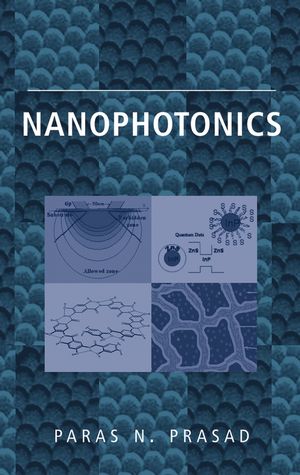NanophotonicsISBN: 978-0-471-64988-5
Hardcover
432 pages
March 2004
 This is a Print-on-Demand title. It will be printed specifically to fill your order. Please allow an additional 15-20 days delivery time. The book is not returnable.
|
||||||
Acknowledgments.
1. Introduction.
1.1 Nanophotonics—An Exciting Frontier in Nanotechnology.
1.2 Nanophotonics at a Glance.
1.3 Multidisciplinary Education, Training, and Research.
1.4. Rationale for this Book.
1.5 Opportunities for Basic Research and Development of New Technologies.
1.6 Scope of this Book.
References.
2. Foundations for Nanophotonics.
2.1 Photons and Electrons: Similarities and Differences.
2.1.1 Free-Space Propagation.
2.1.2 Confinement of Photons and Electrons.
2.1.3 Propagation Through a Classically Forbidden Zone: Tunneling.
2.1.4 Localization Under a Periodic Potential: Bandgap.
2.1.5 Cooperative Effects for Photons and Electrons.
2.2 Nanoscale Optical Interactions.
2.2.1 Axial Nanoscopic Localization.
2.2.2 Lateral Nanoscopic Localization.
2.3 Nanoscale Confinement of Electronic Interactions.
2.3.1 Quantum Confinement Effects.
2.3.2 Nanoscopic Interaction Dynamics.
2.3.3 New Cooperative Transitions.
2.3.4 Nanoscale Electronic Energy Transfer.
2.3.5 Cooperative Emission.
2.4 Highlights of the Chapter.
References.
3. Near-Field Interaction and Microscopy.
3.1 Near-Field Optics.
3.2 Theoretical Modeling of Near-Field Nanoscopic Interactions.
3.3 Near-Field Microscopy.
3.4 Examples of Near-Field Studies.
3.4.1 Study of Quantum Dots.
3.4.2 Single-Molecule Spectroscopy.
3.4.3 Study of Nonlinear Optical Processes.
3.5 Apertureless Near-Field Spectroscopy and Microscopy.
3.6 Nanoscale Enhancement of Optical Interactions.
3.7 Time- and Space-Resolved Studies of Nanoscale Dynamics.
3.8 Commercially Available Sources for Near-Field Microscope.
3.9 Highlights of the Chapter.
References.
4. Quantum-Confined Materials.
4.1 Inorganic Semiconductors.
4.1.1 Quantum Wells.
4.1.2 Quantum Wires.
4.1.3 Quantum Dots.
4.1.4 Quantum Rings.
4.2 Manifestations of Quantum Confinement.
4.2.1 Optical Properties.
4.2.2 Examples.
4.2.3 Nonlinear Optical Properties.
4.2.4 Quantum-Confined Stark Effect.
4.3 Dielectric Confinement Effect.
4.4 Superlattices.
4.5 Core-Shell Quantum Dots and Quantum Dot-Quantum Wells.
4.6 Quantum-Confined Structures as Lasing Media.
4.7 Organic Quantum-Confined Structures.
4.8 Highlights of the Chapter.
References.
5. Plasmonics.
5.1 Metallic Nanoparticles and Nanorods.
5.2 Metallic Nanoshells.
5.3 Local Field Enhancement.
5.4 Subwavelength Aperture Plasmonics.
5.5 Plasmonic Wave Guiding.
5.6 Applications of Metallic Nanostructures.
5.7 Radiative Decay Engineering.
5.8 Highlights of the Chapter.
References.
6. Nanocontrol of Excitation Dynamics.
6.1 Nanostructure and Excited States.
6.2 Rare-Earth Doped Nanostructures.
6.3 Up-Converting Nanophores.
6.4 Photon Avalanche.
6.5 Quantum Cutting.
6.6 Site Isolating Nanoparticles.
6.7 Highlights of the Chapter.
References.
7. Growth and Characterization of Nanomaterials.
7.1 Growth Methods for Nanomaterials.
7.1.1 Epitaxial Growth.
7.1.2 Laser-Assisted Vapor Deposition (LAVD).
7.1.3 Nanochemistry.
7.2 Characterization of Nanomaterials.
7.2.1 X-Ray Characterization.
7.2.1.1 X-Ray Diffraction.
7.2.1.2 X-Ray Photoelectron Spectroscopy.
7.2.2 Electron Microscopy.
7.2.2.1 Transmission Electron Microscopy (TEM).
7.2.2.2 Scanning Electron Microscopy (SEM).
7.2.3 Other Electron Beam Techniques.
7.2.4 Scanning Probe Microscopy (SPM).
7.3 Highlights of the Chapter.
References.
8. Nanostructured Molecular Architectures.
8.1 Noncovalent Interactions.
8.2 Nanostructured Polymeric Media.
8.3 Molecular Machines.
8.4 Dendrimers.
8.5 Supramolecular Structures.
8.6 Monolayer and Multilayer Molecular Assemblies.
8.7 Highlights of the Chapter.
References.
9. Photonic Crystals.
9.1 Basics Concepts.
9.2 Theoretical Modeling of Photonic Crystals.
9.3 Features of Photonic Crystals.
9.4 Methods of Fabrication.
9.5 Photonic Crystal Optical Circuitry.
9.6 Nonlinear Photonic Crystals.
9.7 Photonic Crystal Fibers (PCF).
9.8 Photonic Crystals and Optical Communications.
9.9 Photonic Crystal Sensors.
9.10 Highlights of the Chapter.
References.
10. Nanocomposites.
10.1 Nanocomposites as Photonic Media.
10.2 Nanocomposite Waveguides.
10.3 Random Lasers: Laser Paints.
10.4 Local Field Enhancement.
10.5 Multiphasic Nanocomposites.
10.6 Nanocomposites for Optoelectronics.
10.7 Polymer-Dispersed Liquid Crystals (PDLC).
10.8 Nanocomposite Metamaterials.
10.9 Highlights of the Chapter.
References.
11. Nanolithography.
11.1 Two-Photon Lithography.
11.2 Near-Field Lithography.
11.3 Near-Field Phase-Mask Soft Lithography.
11.4 Plasmon Printing.
11.5 Nanosphere Lithography.
11.6 Dip-Pen Nanolithography.
11.7 Nanoimprint Lithography.
11.8 Photonically Aligned Nanoarrays.
11.9 Highlights of the Chapter.
References.
12. Biomaterials and Nanophotonics.
12.1 Bioderived Materials.
12.2 Bioinspired Materials.
12.3 Biotemplates.
12.4 Bacteria as Biosynthesizers.
12.5 Highlights of the Chapter.
References.
13. Nanophotonics for Biotechnology and Nanomedicine.
13.1 Near-Field Bioimaging.
13.2 Nanoparticles for Optical Diagnostics and Targeted Therapy.
13.3 Semiconductor Quantum Dots for Bioimaging.
13.4 Up-Converting Nanophores for Bioimaging.
13.5 Biosensing.
13.6 Nanoclinics for Optical Diagnostics and Targeted Therapy.
13.7 Nanoclinic Gene Delivery.
13.8 Nanoclinics for Photodynamic Therapy.
13.9 Highlights of the Chapter.
References.
14. Nanophotonics and the Marketplace.
14.1 Nanotechnology, Lasers, and Photonics.
14.1.1 Nanonetchnology.
14.1.2 Worldwide Laser Sales.
14.1.3 Photonics.
14.1.4 Nanophotonics.
14.2 Optical Nanomaterials.
14.2.1 Nanoparticle Coatings.
14.2.2 Sunscreen Nanoparticles.
14.2.3 Self-Cleaning Glass.
14.2.4 Fluorescent Quantum Dots.
14.2.5 Nanobarcodes.
14.2.6 Photonic Crystals.
14.2.7 Photonic Crystal Fibers.
14.3 Quantum-Confined Lasers.
14.4 Near-Field Microscopy.
14.5 Nanolithography.
14.6 Future Outlook for Nanophotonics.
14.6.1 Power Generation and Conversion.
14.6.2 Information Technology.
14.6.3 Sensor Technology.
14.6.4 Nanomedicine.
14.7 Highlights of the Chapter.
References.
Index.



